The Influence of Filler Loading and Alkaline Treatment on the Mechanical Properties of Palm Kernel Cake Filler Reinforced Epoxy Composites
Abstract
:1. Introduction
2. Methodology
2.1. Materials
2.2. Fabrication of Specimen Test
2.3. Surface Modification with Alkaline Treatment
2.4. Mechanical Testing
2.5. Microscopic Analysis
2.6. Characterisation of PKFC/Epoxy Composite
3. Results and Discussion
3.1. Tensile Properties
3.2. Flexural Properties
3.3. Izod Impact Properties
3.4. Effect of Alkaline Treatment
3.5. Fourier Transform Infrared Spectroscopy
3.6. Thermogravimetric Analysis
3.7. Differential Scanning Calorimetric
4. Conclusions
Author Contributions
Funding
Institutional Review Board Statement
Informed Consent Statement
Data Availability Statement
Acknowledgments
Conflicts of Interest
References
- Tezara, C.; Hadi, A.E.; Siregar, J.P.; Muhamad, Z.; Hamdan, M.H.M.; Oumer, A.N.; Jaafar, J.; Irawan, A.P.; Rihayat, T.; Fitriyana, D.F. The Effect of Hybridisation on Mechanical Properties and Water Absorption Behaviour of Woven Jute/Ramie Reinforced Epoxy Composites. Polymers 2021, 13, 2964. [Google Scholar] [CrossRef]
- Siregar, J.P.; Jaafar, J.; Cionita, T.; Jie, C.C.; Bachtiar, D.; Rejab, M.R.M.; Asmara, Y.P. The Effect of Maleic Anhydride Polyethylene on Mechanical Properties of Pineapple Leaf Fibre Reinforced Polylactic Acid Composites. Int. J. Precis. Eng. Manuf.-Green Technol. 2019, 6, 101–112. [Google Scholar] [CrossRef]
- Irawan, A.P.; Fitriyana, D.F.; Tezara, C.; Siregar, J.P.; Laksmidewi, D.; Baskara, G.D.; Abdullah, M.Z.; Junid, R.; Hadi, A.E.; Hamdan, M.H.M. Overview of the Important Factors Influencing the Performance of Eco-Friendly Brake Pads. Polymers 2022, 14, 1180. [Google Scholar] [CrossRef] [PubMed]
- Fitriyana, D.F.; Ismail, R.; Santosa, Y.I.; Nugroho, S.; Hakim, A.J.; Al Mulqi, M.S. Hydroxyapatite Synthesis from Clam Shell Using Hydrothermal Method: A Review. In Proceedings of the 2019 International Biomedical Instrumentation and Technology Conference (IBITeC), Special Region of Yogyakarta, Indonesia, 23–24 October 2019; Volume 1, pp. 7–11. [Google Scholar]
- Fitriyana, D.F.; Nugraha, F.W.; Laroybafih, M.B.; Ismail, R.; Bayuseno, A.P.; Muhamadin, R.C.; Ramadan, M.B.; Qudus, A.R.A.; Siregar, J.P. The Effect of Hydroxyapatite Concentration on the Mechanical Properties and Degradation Rate of Biocomposite for Biomedical Applications. In Proceedings of the IOP Conference Series: Earth and Environmental Science; IOP Publishing: Bristol, UK, 2022; Volume 969, p. 012045. [Google Scholar]
- Ismail, R.; Laroybafih, M.B.; Fitriyana, D.F.; Nugroho, S.; Santoso, Y.I.; Hakim, A.J.; al Mulqi, M.S.; Bayuseno, A.P. The Effect of Hydrothermal Holding Time on The Characterization of Hydroxyapatite Synthesized from Green Mussel Shells. J. Adv. Res. Fluid Mech. Therm. Sci. 2021, 80, 84–93. [Google Scholar] [CrossRef]
- Ismail, R.; Fitriyana, D.F.; Santosa, Y.I.; Nugroho, S.; Hakim, A.J.; Al Mulqi, M.S.; Jamari, J.; Bayuseno, A.P. The Potential Use of Green Mussel (Perna Viridis) Shells for Synthetic Calcium Carbonate Polymorphs in Biomaterials. J. Cryst. Growth 2021, 572, 126282. [Google Scholar] [CrossRef]
- Tezara, C.; Zalinawati, M.; Siregar, J.P.; Jaafar, J.; Hamdan, M.H.M.; Oumer, A.N.; Chuah, K.H. Effect of Stacking Sequences, Fabric Orientations, and Chemical Treatment on the Mechanical Properties of Hybrid Woven Jute–Ramie Composites. Int. J. Precis. Eng. Manuf.-Green Technol. 2021, 9, 273–285. [Google Scholar]
- Jaafar, J.; Parlaungan, J.; Mohd, S.; Mat, B.; Tezara, P.; Sharmiza, C. Influence of Selected Treatment on Tensile Properties of Short Pineapple Leaf Fiber Reinforced Tapioca Resin Biopolymer Composites. J. Polym. Environ. 2018, 26, 4271–4281. [Google Scholar] [CrossRef]
- Brebu, M. Environmental Degradation of Plastic Composites with Natural Fillers—A Review. Polymers 2020, 12, 166. [Google Scholar] [CrossRef] [PubMed] [Green Version]
- Hamdan, M.H.M.; Siregar, J.P.; Bachtiar, D.; Rejab, M.R.M.; Samykano, M.; Agung, E.H.; Tezara, C.; Jaafar, J. Effect of Alkaline Treatment on Mechanical Properties of Woven Ramie Reinforced Thermoset Composite. In Proceedings of the IOP Conference Series: Materials Science and Engineering; IOP Publishing: Bristol, UK, 2017; Volume 257. [Google Scholar]
- Arjmandi, R.; Hassan, A.; Majeed, K.; Zakaria, Z. Rice Husk Filled Polymer Composites. Int. J. Polym. Sci. 2015, 2015, 501471. [Google Scholar] [CrossRef]
- Patel, N.; Jain, P. An Investigation on Mechanical Properties in Randomly Oriented Short Natural Fiber Reinforced Composites. Mater. Today Proc. 2021, 37, 469–479. [Google Scholar] [CrossRef]
- Olaitan, A.J.; Terhemen, A.; King, G.; Oluwatoyin, O. Comparative Assessment of Mechanical Properties of Groundnut Shell and Rice Husk Reinforced Epoxy Composites. Am. J. Mech. Eng. 2017, 5, 76–86. [Google Scholar]
- Bisht, N.; Gope, P.C. Effect of Alkali Treatment on Mechanical Properties of Rice Husk Flour Reinforced Epoxy Bio-Composite. Mater. Today Proc. 2018, 5, 24330–24338. [Google Scholar] [CrossRef]
- Emdadi, Z.; Asim, N.; Yarmo, M.A.; Sopian, K. Effect of Chemical Treatments on Rice Husk (RH) Water Absorption Property. Int. J. Chem. Eng. Appl. 2015, 6, 273. [Google Scholar] [CrossRef] [Green Version]
- Yeh, S.-K.; Hsieh, C.-C.; Chang, H.-C.; Yen, C.C.C.; Chang, Y.-C. Synergistic Effect of Coupling Agents and Fiber Treatments on Mechanical Properties and Moisture Absorption of Polypropylene–Rice Husk Composites and Their Foam. Compos. Part A Appl. Sci. Manuf. 2015, 68, 313–322. [Google Scholar]
- Oushabi, A.; Sair, S.; Hassani, F.O.; Abboud, Y.; Tanane, O.; El Bouari, A. The Effect of Alkali Treatment on Mechanical, Morphological and Thermal Properties of Date Palm Fibers (DPFs): Study of the Interface of DPF–Polyurethane Composite. S. Afr. J. Chem. Eng. 2017, 23, 116–123. [Google Scholar] [CrossRef]
- Gopinath, A.; Kumar, M.S.; Elayaperumal, A. Experimental Investigations on Mechanical Properties of Jute Fiber Reinforced Composites with Polyester and Epoxy Resin Matrices. Procedia Eng. 2014, 97, 2052–2063. [Google Scholar] [CrossRef] [Green Version]
- John, M.J.; Francis, B.; Varughese, K.T.; Thomas, S. Effect of Chemical Modification on Properties of Hybrid Fiber Biocomposites. Compos. Part A Appl. Sci. Manuf. 2008, 39, 352–363. [Google Scholar]
- Lopattananon, N.; Panawarangkul, K.; Sahakaro, K.; Ellis, B. Performance of Pineapple Leaf Fiber–Natural Rubber Composites: The Effect of Fiber Surface Treatments. J. Appl. Polym. Sci. 2006, 102, 1974–1984. [Google Scholar] [CrossRef]
- Ray, D.; Sarkar, B.K.; Rana, A.K.; Bose, N.R. Effect of Alkali Treated Jute Fibres on Composite Properties. Bull. Mater. Sci. 2001, 24, 129–135. [Google Scholar]
- Norizan, M.N.; Abdan, K.; Salit, M.S.; Mohamed, R. The Effect of Alkaline Treatment on the Mechanical Properties of Treated Sugar Palm Yarn Fibre Reinforced Unsaturated Polyester Composites Reinforced with Different Fibre Loadings of Sugar Palm Fibre. Sains Malays 2018, 47, 699–705. [Google Scholar] [CrossRef]
- Saravanakumaar, A.; Senthilkumar, A.; Saravanakumar, S.S.; Sanjay, M.R.; Khan, A. Impact of Alkali Treatment on Physico-Chemical, Thermal, Structural and Tensile Properties of Carica Papaya Bark Fibers. Int. J. Polym. Anal. Charact. 2018, 23, 529–536. [Google Scholar] [CrossRef]
- Sathishkumar, S.; Suresh, A.V.; Nagamadhu, M.; Krishna, M. The Effect of Alkaline Treatment on Their Properties of Jute Fiber Mat and Its Vinyl Ester Composites. Mater. Today Proc. 2017, 4, 3371–3379. [Google Scholar] [CrossRef]
- Prince, M.; Kumar, A.P.; Mahesh, E.; Raj, G.S.; Vinayagamoorthi, M.A.; Sivaraman, P.; Prabhu, M.K. Mechanical Characterization of Alkaline Treated Ananus Comosus and Musa Sepientum Fibers Reinforced Epoxy Hybrid Composites. Mater. Today Proc. 2022, 62, 2320–2325. [Google Scholar] [CrossRef]
- Nagaraj, N.; Balasubramaniam, S.; Venkataraman, V.; Manickam, R.; Nagarajan, R.; Oluwarotimi, I.S. Effect of Cellulosic Filler Loading on Mechanical and Thermal Properties of Date Palm Seed/Vinyl Ester Composites. Int. J. Biol. Macromol. 2020, 147, 53–66. [Google Scholar] [CrossRef]
- Bisht, P.; Pandey, K.K.; Srinivas, G. Physiochemical Characterization and Thermal Behaviour of Transparent Wood Composite. Mater. Today Commun. 2022, 31, 103767. [Google Scholar] [CrossRef]
- Bessa, W.; Trache, D.; Derradji, M.; Tarchoun, A.F. Morphological, Thermal and Mechanical Properties of Benzoxazine Resin Reinforced with Alkali Treated Alfa Fibers. Ind. Crop. Prod. 2021, 165, 113423. [Google Scholar] [CrossRef]
- Joy, J.; George, E.; Thomas, S.; Anas, S. Effect of Filler Loading on Polymer Chain Confinement and Thermomechanical Properties of Epoxy/Boron Nitride (h-BN) Nanocomposites. New J. Chem. 2020, 44, 4494–4503. [Google Scholar] [CrossRef]
- Varghese, S.A.; Pulikkalparambil, H.; Rangappa, S.M.; Siengchin, S.; Parameswaranpillai, J. Novel Biodegradable Polymer Films Based on Poly (3-Hydroxybutyrate-Co-3-Hydroxyvalerate) and Ceiba Pentandra Natural Fibers for Packaging Applications. Food Packag. Shelf Life 2020, 25, 100538. [Google Scholar] [CrossRef]
- Khoshnoud, P.; Abu-Zahra, N. Properties of Rigid Polyvinyl Chloride Foam Composites Reinforced with Different Shape Fillers. J. Thermoplast. Compos. Mater. 2017, 30, 1541–1559. [Google Scholar] [CrossRef]
- Kumar, R.; Kumar, K.; Sahoo, P.; Bhowmik, S. Study of Mechanical Properties of Wood Dust Reinforced Epoxy Composite. Procedia Mater. Sci. 2014, 6, 551–556. [Google Scholar]
- Bai, T.; Wang, D.; Yan, J.; Cheng, W.; Cheng, H.; Shi, S.Q.; Wang, G.; Han, G. Wetting Mechanism and Interfacial Bonding Performance of Bamboo Fiber Reinforced Epoxy Resin Composites. Compos. Sci. Technol. 2021, 213, 108951. [Google Scholar] [CrossRef]
- Alzebdeh, K.I.; Nassar, M.M.A. Polymer Blend Natural Fiber Based Composites. In Fiber Reinforced Composites Constituents, Compatibility, Perspectives, and Applications; Woodhead Publishing Series in Composites Science and Engineering: Sawston, UK, 2021; pp. 214–238. ISBN 9780128210901. [Google Scholar]
- Nagappan, S.; Subramani, S.P.; Palaniappan, S.K.; Mylsamy, B. Impact of Alkali Treatment and Fiber Length on Mechanical Properties of New Agro Waste Lagenaria Siceraria Fiber Reinforced Epoxy Composites. J. Nat. Fibers 2021, 1–12. [Google Scholar] [CrossRef]
- Bhaskar, J.; Singh, V.K. Physical and Mechanical Properties of Coconut Shell Particle Reinforced-Epoxy Composite. J. Mater. Environ. Sci. 2013, 4, 227–232. [Google Scholar]
- Theja, K.K.; Bharathiraja, G.; Murugan, V.S.; Muniappan, A. Evaluation of Mechanical Properties of Tea Dust Filler Reinforced Polymer Composite. Mater. Today Proc. 2021, in press.
- Saba, N.; Alothman, O.Y.; Almutairi, Z.; Jawaid, M.; Ghori, W. Date Palm Reinforced Epoxy Composites: Tensile, Impact and Morphological Properties. J. Mater. Res. Technol. 2019, 8, 3959–3969. [Google Scholar]
- Pradhan, S.; Rajkonwar, A.; Acharya, S.K. Study of Mechanical and Abrasive Wear Properties of Lantana Camara Particulate Reinforced Epoxy Composite. Mater. Today Proc. 2019, 19, 264–268. [Google Scholar]
- Senthil Muthu Kumar, T.; Senthilkumar, K.; Chandrasekar, M.; Subramaniam, S.; Mavinkere Rangappa, S.; Siengchin, S.; Rajini, N. Influence of Fillers on the Thermal and Mechanical Properties of Biocomposites: An Overview. In Biofibers and Biopolymers for Biocomposites: Synthesis, Characterization and Properties; Khan, A., Mavinkere Rangappa, S., Siengchin, S., Asiri, A.M., Eds.; Springer International Publishing: Cham, Switzerland, 2020; pp. 111–133. ISBN 978-3-030-40301-0. [Google Scholar]
- Thakur, R.K.; Singh, K.K. Influence of Fillers on Polymeric Composite during Conventional Machining Processes: A Review. J. Braz. Soc. Mech. Sci. Eng. 2021, 43, 94. [Google Scholar]
- Nguyen, T.A.; Nguyen, T.H. Banana Fiber-Reinforced Epoxy Composites: Mechanical Properties and Fire Retardancy. Int. J. Chem. Eng. 2021, 2021, 1973644. [Google Scholar]
- Bisht, N.; Gope, P.C. Mechanical Properties of Rice Husk Flour Reinforced Epoxy Bio-Composite. Int J. Eng. Res. Appl. 2015, 5, 123128. [Google Scholar]
- Awais, H.; Nawab, Y.; Amjad, A.; Anjang, A.; Akil, H.M.; Abidin, M.S.Z. Environmental Benign Natural Fibre Reinforced Thermoplastic Composites: A Review. Compos. Part C Open Access 2021, 4, 100082. [Google Scholar]
- Raju, G.U.; Kumarappa, S.; Gaitonde, V.N. Mechanical and Physical Characterization of Agricultural Waste Reinforced Polymer Composites. J. Mater. Environ. Sci. 2012, 3, 907–916. [Google Scholar]
- Rizal, S.; Fizree, H.M.; Owolabi, F.A.T.; Gopakumar, D.A.; Paridah, M.T.; Haafiz, M.K.M.; Fazita, M.R.M.; Syakir, M.I.; Khalil, H.P.S.A. Utilization of Agrowaste-Derived Nanoparticles as Reinforcement in Microfilled Epoxy Composites. BioResources 2019, 14, 5365–5379. [Google Scholar]
- Gairola, S.; Gairola, S.; Sharma, H.; Rakesh, P.K. Impact Behavior of Pine Needle Fiber/Pistachio Shell Filler Based Epoxy Composite. In Proceedings of the Journal of Physics: Conference Series; IOP Publishing: Bristol, UK, 2019; Volume 1240, p. 012096. [Google Scholar]
- Poletto, M.; Zeni, M.; Zattera, A.J. Effects of Wood Flour Addition and Coupling Agent Content on Mechanical Properties of Recycled Polystyrene/Wood Flour Composites. J. Thermoplast. Compos. Mater. 2012, 25, 821–833. [Google Scholar] [CrossRef]
- Mahjoub, R.; Yatim, J.M.; Sam, A.R.M.; Hashemi, S.H. Tensile Properties of Kenaf Fiber Due to Various Conditions of Chemical Fiber Surface Modifications. Constr. Build. Mater. 2014, 55, 103–113. [Google Scholar] [CrossRef]
- Melo, J.D.D.; Carvalho, L.F.M.; Medeiros, A.M.; Souto, C.R.O.; Paskocimas, C.A. A Biodegradable Composite Material Based on Polyhydroxybutyrate (PHB) and Carnauba Fibers. Compos. Part B Eng. 2012, 43, 2827–2835. [Google Scholar] [CrossRef]
- Rizal, S.; Gopakumar, D.A.; Thalib, S.; Huzni, S.; Abdul Khalil, H.P.S. Interfacial Compatibility Evaluation on the Fiber Treatment in the Typha Fiber Reinforced Epoxy Composites and Their Effect on the Chemical and Mechanical Properties. Polymers 2018, 10, 1316. [Google Scholar] [CrossRef] [Green Version]
- Negawo, T.A.; Polat, Y.; Akgul, Y.; Kilic, A.; Jawaid, M. Mechanical and Dynamic Mechanical Thermal Properties of Ensete Fiber/Woven Glass Fiber Fabric Hybrid Composites. Compos. Struct. 2021, 259, 113221. [Google Scholar] [CrossRef]
- Elenga, R.G.; Djemia, P.; Tingaud, D.; Chauveau, T.; Maniongui, J.G.; Dirras, G.F. Effects of Alkali Treatment on the Microstructure, Composition, and Properties of the Raffia Textilis Fiber. BioResources 2013, 8, 2934–2949. [Google Scholar] [CrossRef] [Green Version]
- Ashok, R.B.; Srinivasa, C.V.; Basavaraju, B. Study on Morphology and Mechanical Behavior of Areca Leaf Sheath Reinforced Epoxy Composites. Adv. Compos. Hybrid Mater. 2020, 3, 365–374. [Google Scholar] [CrossRef]
- Nasir, N.F.; Mirus, M.F.; Ismail, M. Purification of Crude Glycerol from Transesterification Reaction of Palm Oil Using Direct Method and Multistep Method. In Proceedings of the IOP Conference Series: Materials Science and Engineering; IOP Publishing: Bristol, UK, 2017; Volume 243, p. 012015. [Google Scholar]
- Prabhakar, M.N.; Shah, A.U.R.; Rao, K.C.; Song, J.-I. Mechanical and Thermal Properties of Epoxy Composites Reinforced with Waste Peanut Shell Powder as a Bio-Filler. Fibers Polym. 2015, 16, 1119–1124. [Google Scholar] [CrossRef]
- Ismail, N.F.; Mohd Radzuan, N.A.; Sulong, A.B.; Muhamad, N.; Che Haron, C.H. The Effect of Alkali Treatment on Physical, Mechanical and Thermal Properties of Kenaf Fiber and Polymer Epoxy Composites. Polymers 2021, 13, 2005. [Google Scholar] [CrossRef] [PubMed]
- Chen, H.; Zhang, W.; Wang, X.; Wang, H.; Wu, Y.; Zhong, T.; Fei, B. Effect of Alkali Treatment on Wettability and Thermal Stability of Individual Bamboo Fibers. J. Wood Sci. 2018, 64, 398–405. [Google Scholar] [CrossRef] [Green Version]
- Usmani, M.A.; Khan, I.; Haque, A.; Bhat, A.H.; Mondal, D.; Gazal, U. Biomass-Based Composites from Different Sources: Properties, Characterization, and Transforming Biomass with Ionic Liquids. In Lignocellulosic Fibre and Biomass-Based Composite Materials; Elsevier: Amsterdam, The Netherlands, 2017; pp. 45–76. [Google Scholar]
- Sinha, E.; Rout, S.K. Influence of Fibre-Surface Treatment on Structural, Thermal and Mechanical Properties of Jute Fibre and Its Composite. Bull. Mater. Sci. 2009, 32, 65–76. [Google Scholar] [CrossRef]
- Akhtar, M.N.; Sulong, A.B.; Radzi, M.K.F.; Ismail, N.F.; Raza, M.R.; Muhamad, N.; Khan, M.A. Influence of Alkaline Treatment and Fiber Loading on the Physical and Mechanical Properties of Kenaf/Polypropylene Composites for Variety of Applications. Prog. Nat. Sci. Mater. Int. 2016, 26, 657–664. [Google Scholar] [CrossRef]
- Bryś, A.; Bryś, J.; Ostrowska-Ligęza, E.; Kaleta, A.; Górnicki, K.; Głowacki, S.; Koczoń, P. Wood Biomass Characterization by DSC or FT-IR Spectroscopy. J. Therm. Anal. Calorim. 2016, 126, 27–35. [Google Scholar] [CrossRef] [Green Version]
- Mittal, V.; Sinha, S. Effect of Chemical Treatment on Thermal Properties of Bagasse Fiber-Reinforced Epoxy Composite. Sci. Eng. Compos. Mater. 2017, 24, 237–243. [Google Scholar] [CrossRef]


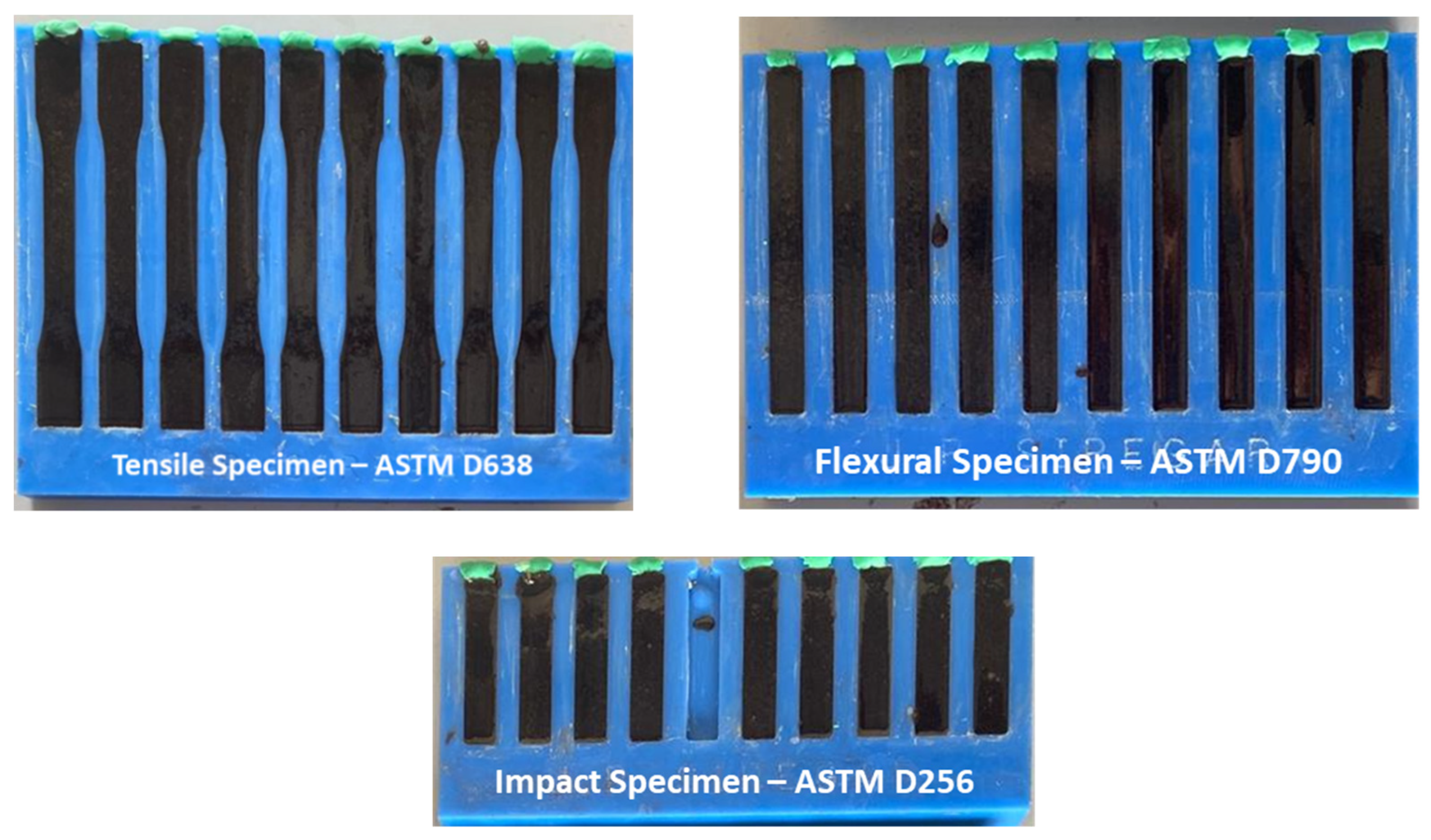
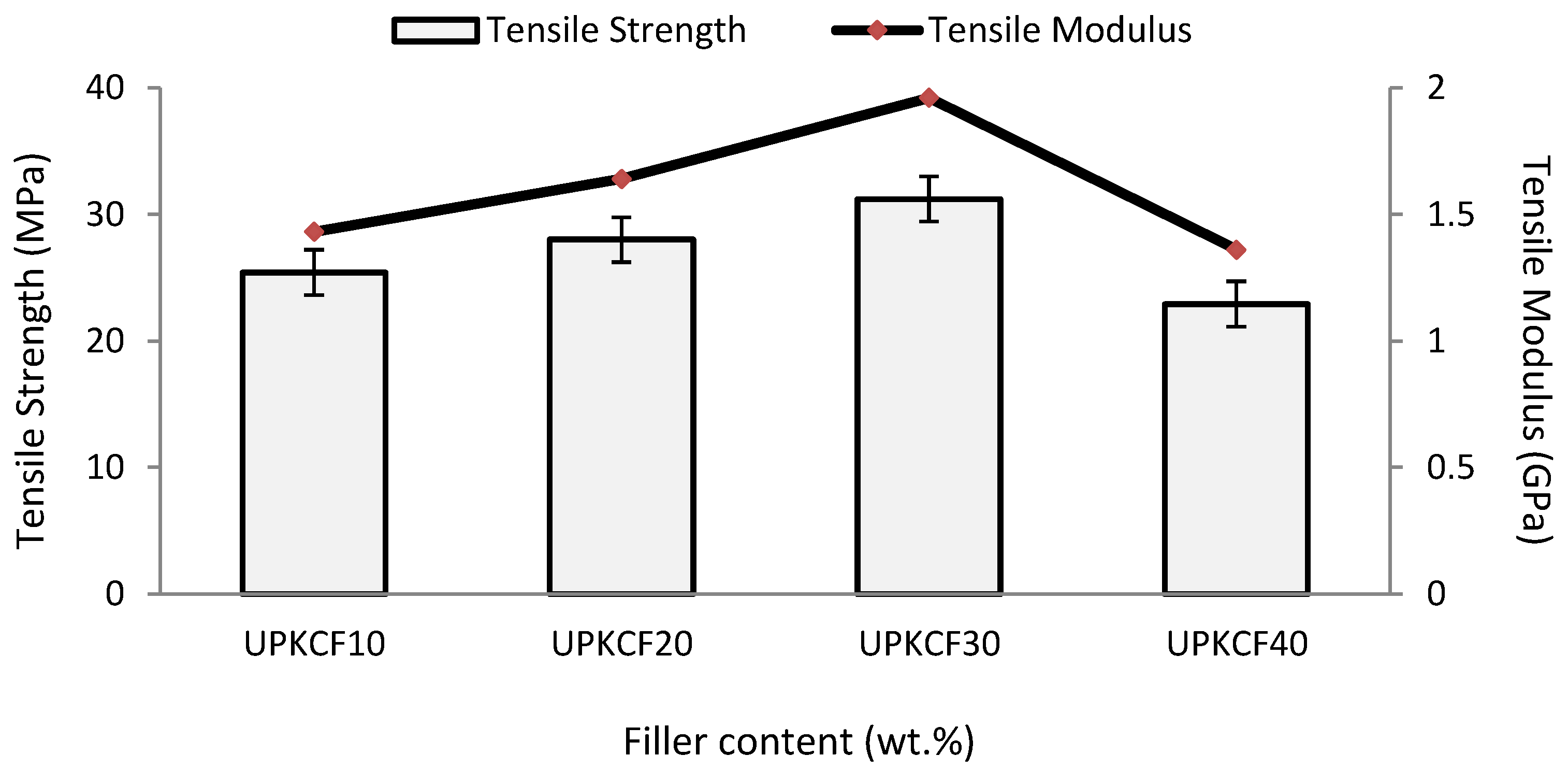


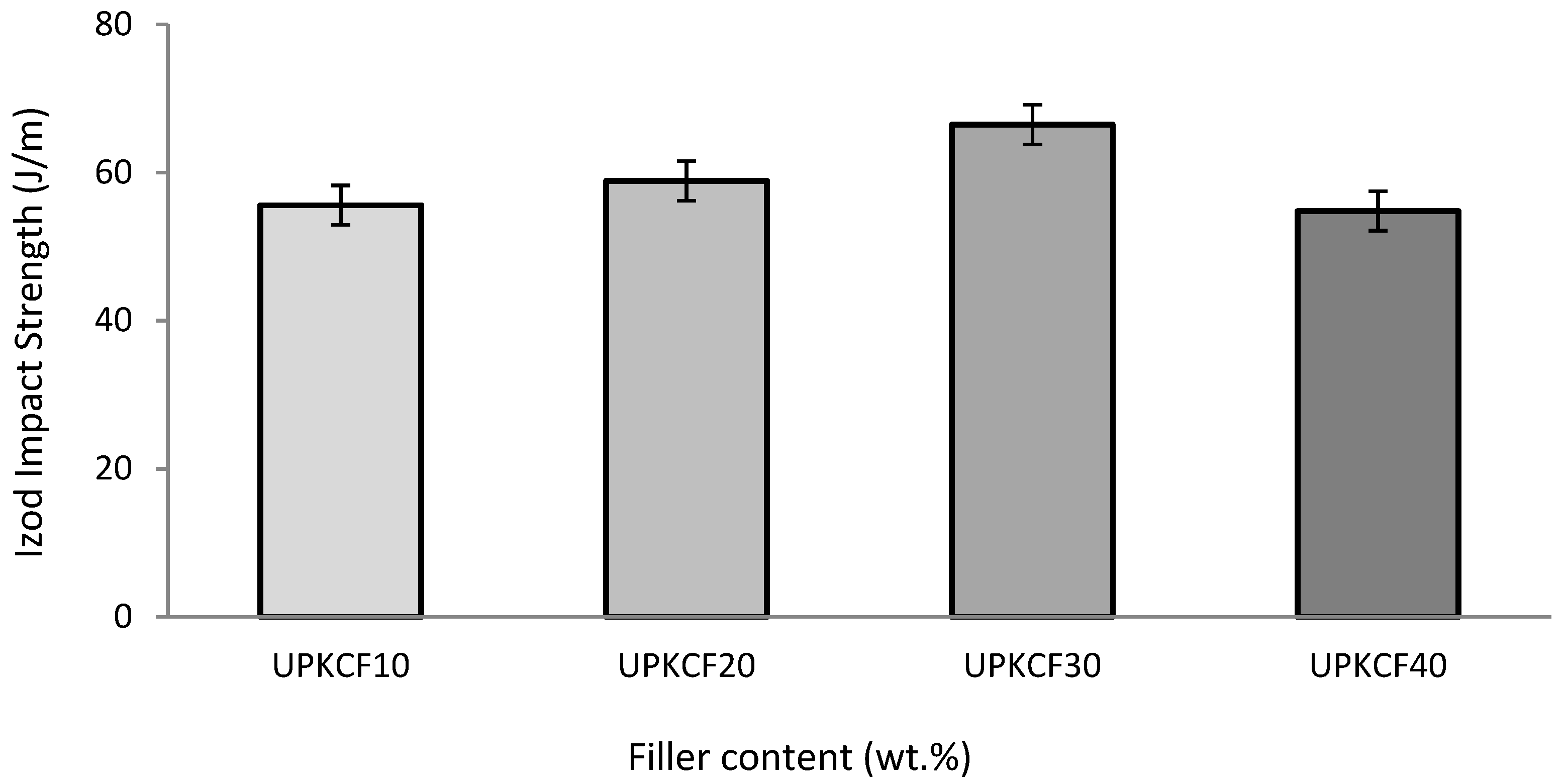
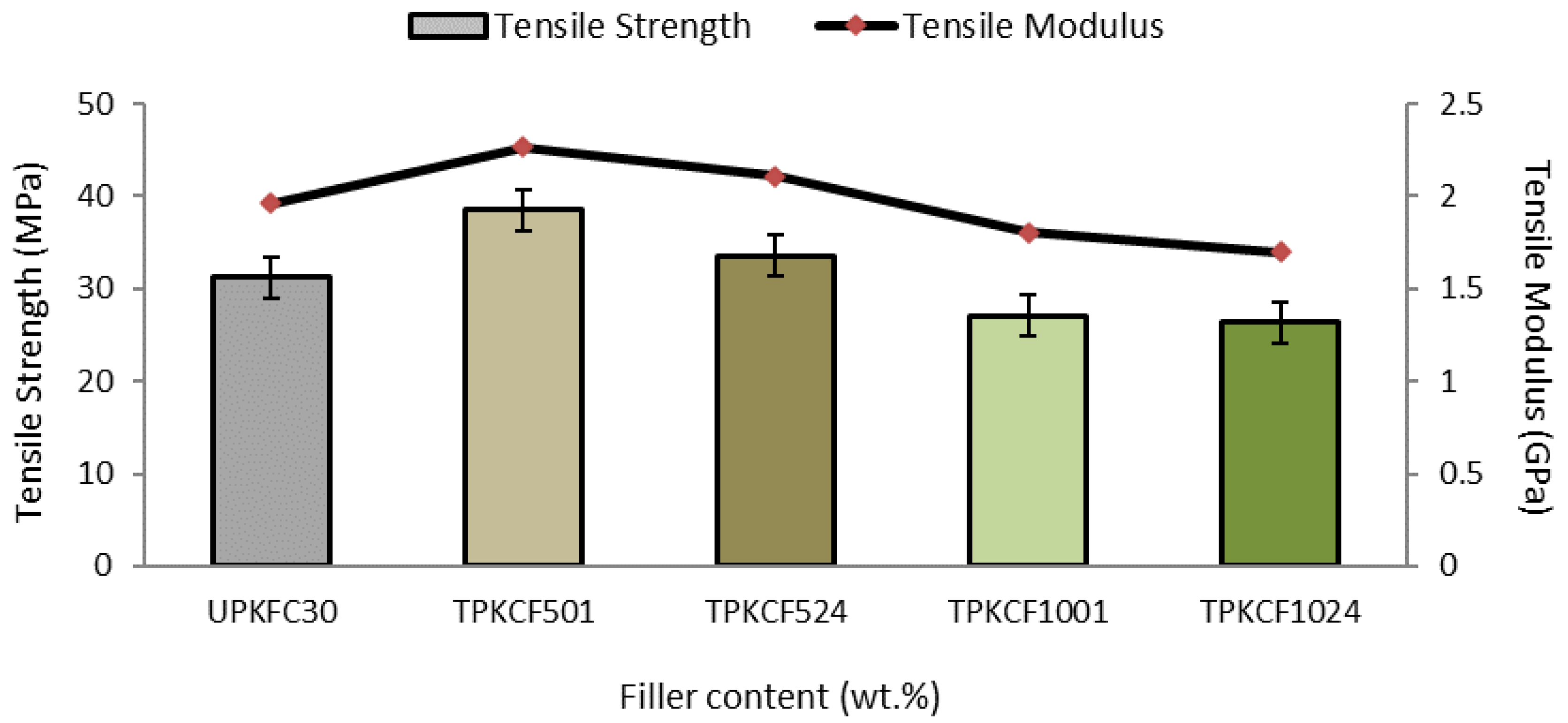
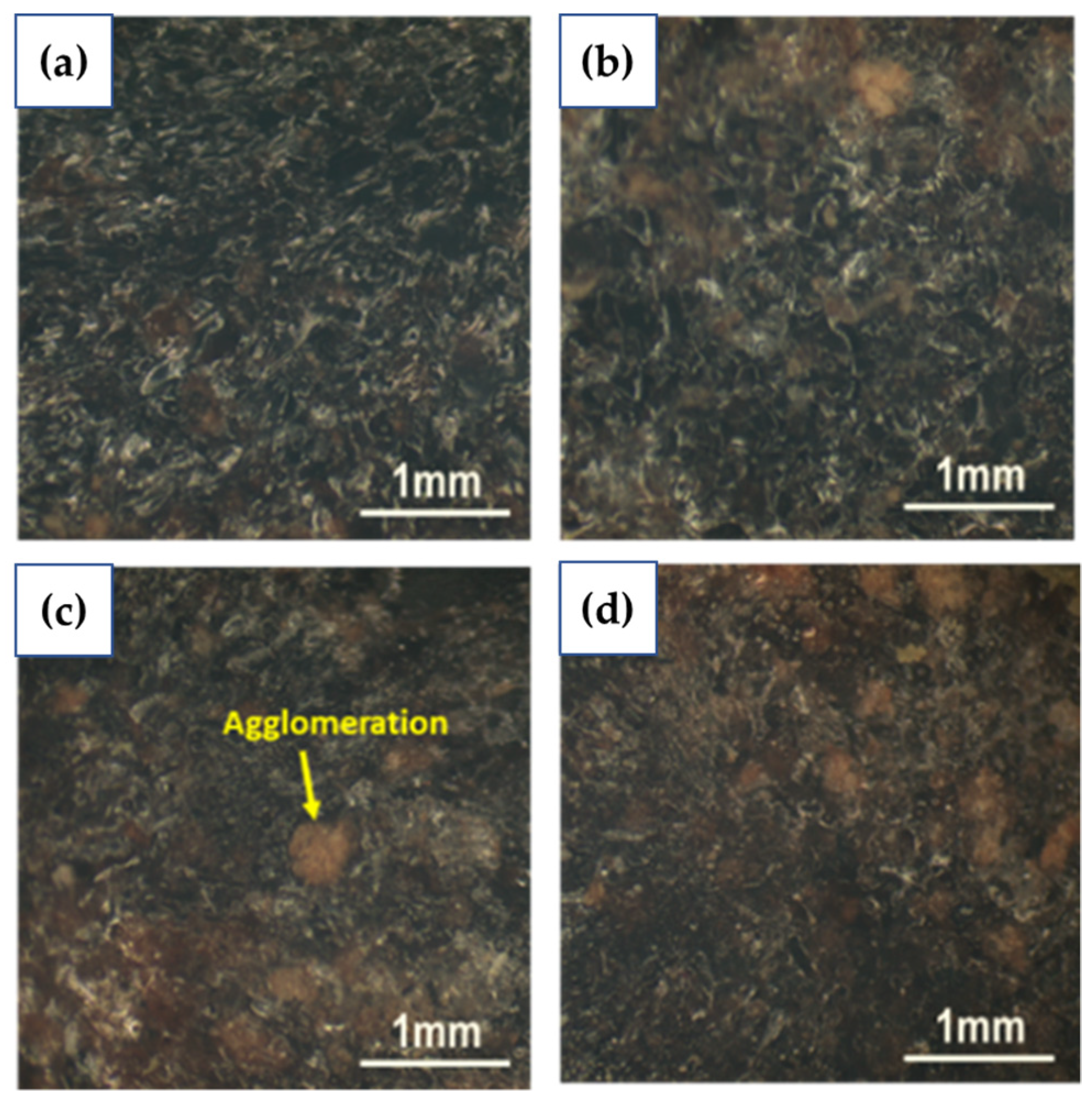
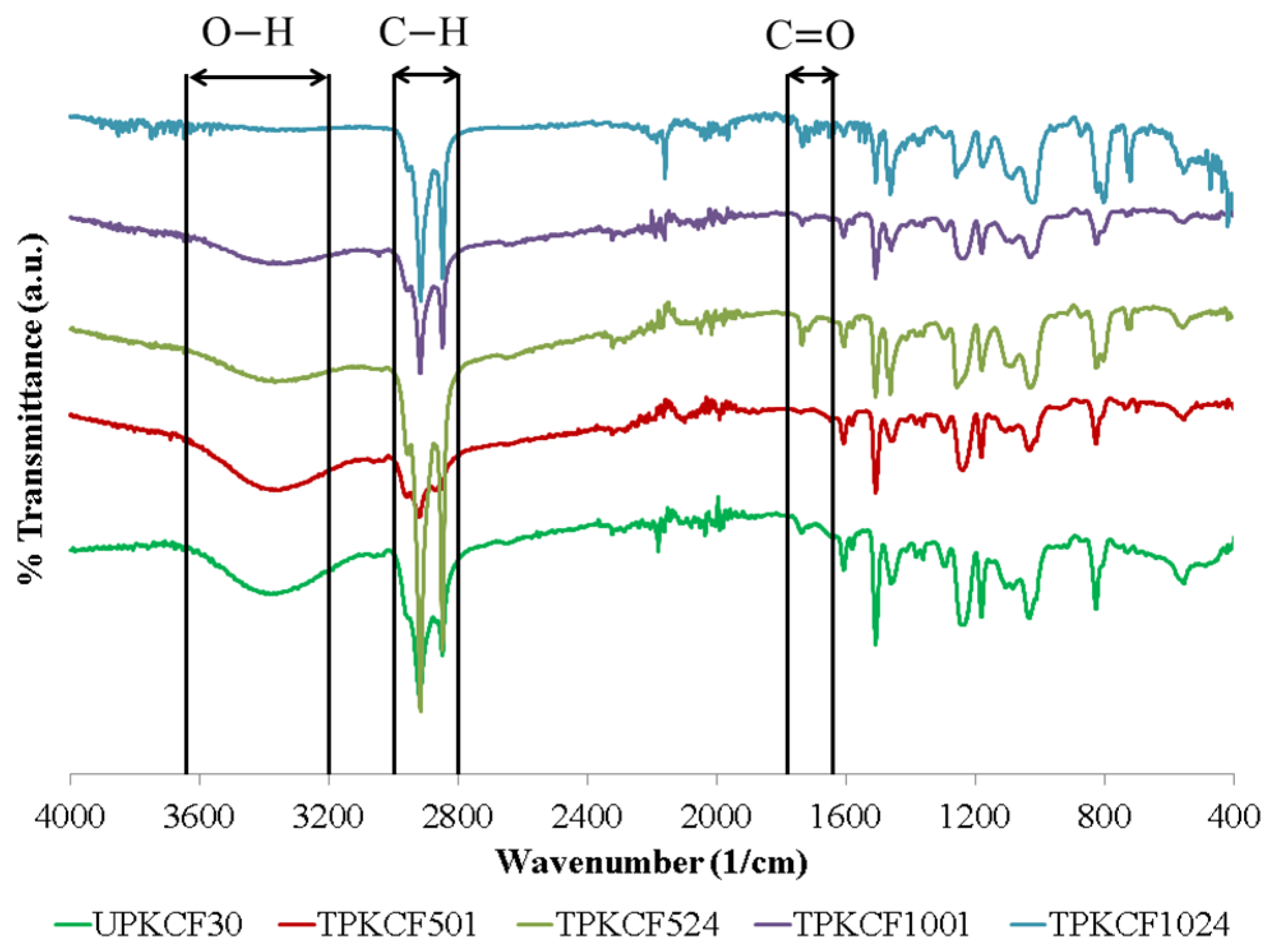



| Property | Value | Unit |
|---|---|---|
| Colour | 100 max | Pt-Co |
| Epoxy group content | 5260–5420 | mmol/kg |
| Viscosity at 25 °C | 12–14 | Pa.s (Poise) |
| Density | 1.16 | Kg/L |
| Filler Loading (%) | Filler Weight (g) | Epoxy Weight (g) | Hardener Weight (g) | Label |
|---|---|---|---|---|
| 10 | 30 | 202.5 | 67.5 | UPKCF10 |
| 20 | 60 | 180 | 60 | UPKCF20 |
| 30 | 90 | 157.5 | 52.5 | UPKCF30 |
| 40 | 120 | 135 | 45 | UPKCF40 |
| NaOH Concentration | Duration Time (h) | Label |
|---|---|---|
| 0% (untreated) | 0 | UPKFC30 |
| 5% | 1 | TPKCF501 |
| 24 | TPKCF524 | |
| 10% | 1 | TPKCF1001 |
| 24 | TPKCF1024 |
| Filler Type | Filler Size | Optimum Filler Loading (wt.%) | Remarks | Ref. |
|---|---|---|---|---|
| Banana | 30 mm | 20 | Increased 37.31% compared to neat epoxy resin | [43] |
| Lagenaria Siceraria | 7 mm | 30 | 23.07 MPa | [36] |
| Rice husk | 125 microns | - | Decreased compared to neat epoxy resin | [44] |
| Coconut shell | 200–800 μm | 20 | 30.60 MPa | [37] |
| Tea dust | - | 50 | 15 MPa | [38] |
| Date palm | 0.8–1 mm | 50 | 25.76 MPa | [39] |
| Lantana camara | - | 20 | 26.31 MPa | [40] |
| Wood dust | 2 μm | 10 | 47.65 MPa | [33] |
| Palm kernel cake filler | 100 mesh | 30 | 31.20 MPa | Current study |
| Filler Type | Filler Size | Optimum Filler Loading (wt.%) | Remarks | Ref. |
|---|---|---|---|---|
| Banana | 30 mm | 20 | Increased 10.13% | [43] |
| Lagenaria Siceraria | 7 mm | 30 | 48.40 MPa | [36] |
| Rice husk | 125 microns | - | Decrease compared to neat epoxy resin | [44] |
| Tea dust | - | 50 | 41 MPa | [38] |
| Lantana camara | - | 20 | 53.4 MPa | [40] |
| Wood dust | 2 microns | 10 | 47.65 MPa | [33] |
| Palm kernel cake filler | 100 mesh | 30 | 39.70 MPa | Current study |
| Filler Type | Filler Size | Optimum Filler Loading (wt.%) | Remarks | Ref. |
|---|---|---|---|---|
| Banana | 30 mm | 20 | Increased 80.99% | [43] |
| Lagenaria Siceraria | 7 mm | 30 | 0.75 J | [36] |
| Rice husk | 125 microns | - | Decreased compared to neat epoxy resin | [44] |
| Tea dust | - | 40 | 625 (J/m2) | [38] |
| Lantana camara | - | 20 | 5.3 (J/cm2) | [40] |
| Hybrid pine needle fibre/pistachio shell filler | - | 20 + 10 | 23.33 KJ/m2 | [48] |
| Palm kernel cake filler | 100 mesh | 30 | 66.48 J/m | Current study |
| Filler Type | Concentration of NaOH (%) | Duration (h) | Result (Optimum) | Ref. |
|---|---|---|---|---|
| Carnauba | 1, 3, and 5 | 1, 2, and 3 | 5% at 1 h | [51] |
| Typha | 5 | 1, 2, 4, and 8 | 5% at 4 h | [52] |
| Kenaf | 5, 7, 10, and 15 | 1, 3, and 24 | 5% at 3 h | [53] |
| Carica Papaya bark | 5 | 15, 30, 45, 60, 75, and 90 min | 5% at 1 h | [24] |
| Raffia textilis | 2.5, 5, and 10 | 12 | 5% | [54] |
| Palm kernel cake filler | 5 and 10 | 1 and 24 | 5% at 1 h | Current study |
Publisher’s Note: MDPI stays neutral with regard to jurisdictional claims in published maps and institutional affiliations. |
© 2022 by the authors. Licensee MDPI, Basel, Switzerland. This article is an open access article distributed under the terms and conditions of the Creative Commons Attribution (CC BY) license (https://creativecommons.org/licenses/by/4.0/).
Share and Cite
Cionita, T.; Siregar, J.P.; Shing, W.L.; Hee, C.W.; Fitriyana, D.F.; Jaafar, J.; Junid, R.; Irawan, A.P.; Hadi, A.E. The Influence of Filler Loading and Alkaline Treatment on the Mechanical Properties of Palm Kernel Cake Filler Reinforced Epoxy Composites. Polymers 2022, 14, 3063. https://doi.org/10.3390/polym14153063
Cionita T, Siregar JP, Shing WL, Hee CW, Fitriyana DF, Jaafar J, Junid R, Irawan AP, Hadi AE. The Influence of Filler Loading and Alkaline Treatment on the Mechanical Properties of Palm Kernel Cake Filler Reinforced Epoxy Composites. Polymers. 2022; 14(15):3063. https://doi.org/10.3390/polym14153063
Chicago/Turabian StyleCionita, Tezara, Januar Parlaungan Siregar, Wong Ling Shing, Cheng Wan Hee, Deni Fajar Fitriyana, Jamiluddin Jaafar, Ramli Junid, Agustinus Purna Irawan, and Agung Efriyo Hadi. 2022. "The Influence of Filler Loading and Alkaline Treatment on the Mechanical Properties of Palm Kernel Cake Filler Reinforced Epoxy Composites" Polymers 14, no. 15: 3063. https://doi.org/10.3390/polym14153063








